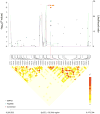Genome-wide association study identifies two susceptibility loci for osteosarcoma
- PMID: 23727862
- PMCID: PMC3910497
- DOI: 10.1038/ng.2645
Genome-wide association study identifies two susceptibility loci for osteosarcoma
Abstract
Osteosarcoma is the most common primary bone malignancy of adolescents and young adults. To better understand the genetic etiology of osteosarcoma, we performed a multistage genome-wide association study consisting of 941 individuals with osteosarcoma (cases) and 3,291 cancer-free adult controls of European ancestry. Two loci achieved genome-wide significance: a locus in the GRM4 gene at 6p21.3 (encoding glutamate receptor metabotropic 4; rs1906953; P = 8.1 × 10⁻⁹) and a locus in the gene desert at 2p25.2 (rs7591996 and rs10208273; P = 1.0 × 10⁻⁸ and 2.9 × 10⁻⁷, respectively). These two loci warrant further exploration to uncover the biological mechanisms underlying susceptibility to osteosarcoma.
Figures


References
-
- Ruza E, Sotillo E, Sierrasesúmaga L, Azcona C, Patiño-Garcia A. Analysis of polymorphisms of the vitamin D receptor, estrogen receptor, and collagen Iα1 genes and their relationship with height in children with bone cancer. J Pediatr Hematol Oncol. 2003;25:780–786. - PubMed
-
- Savage SA, et al. Germ-line genetic variation of TP53 in osteosarcoma. Pediatr Blood Cancer. 2007;49:28–33. - PubMed
Publication types
MeSH terms
Grants and funding
LinkOut - more resources
Full Text Sources
Other Literature Sources
Medical
Molecular Biology Databases

